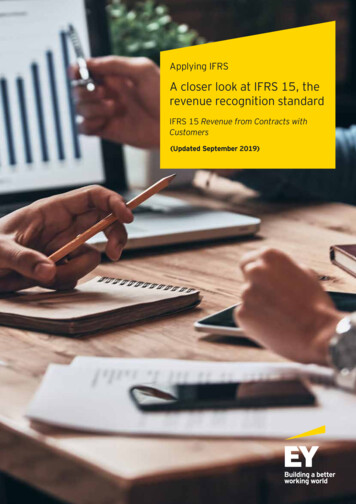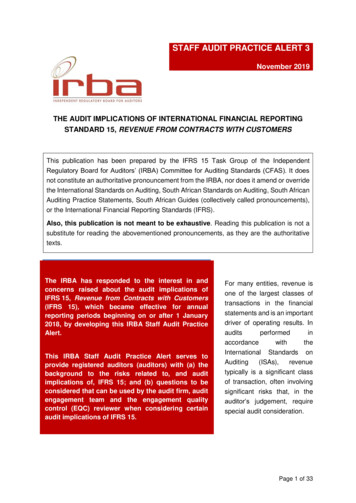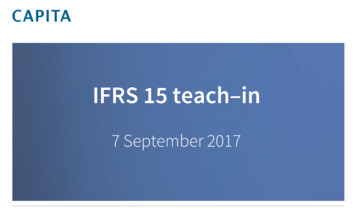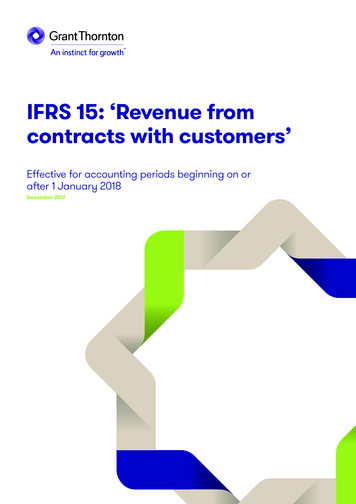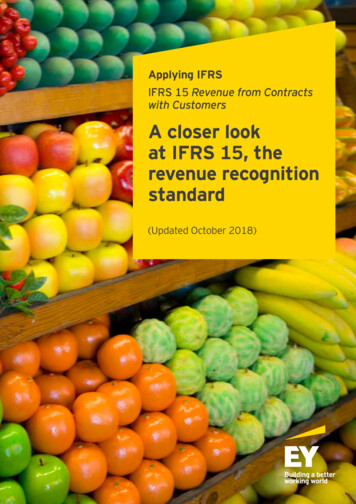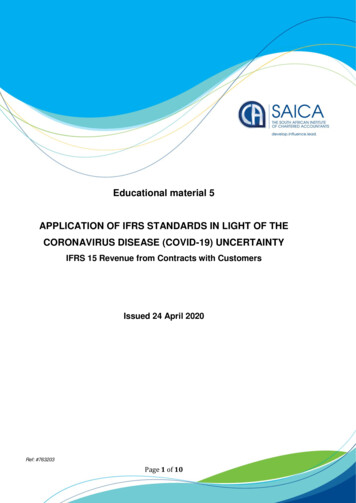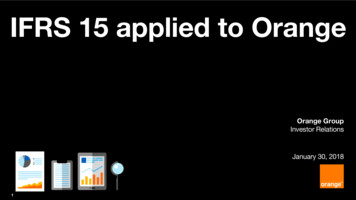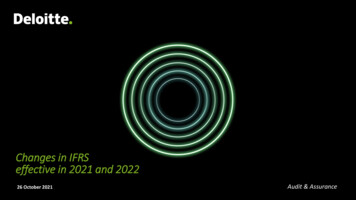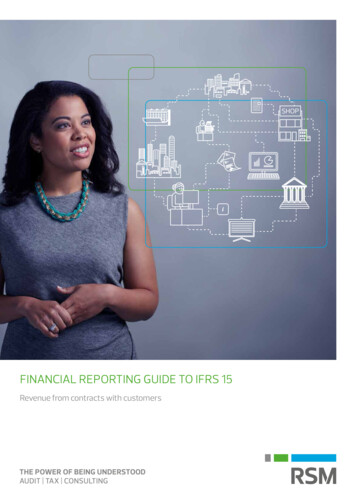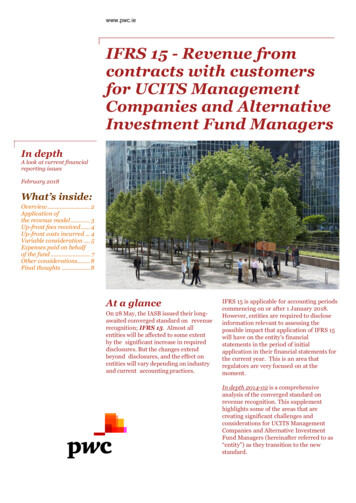
Transcription
www.pwc.ieIFRS 15 - Revenue fromcontracts with customersfor UCITS ManagementCompanies and AlternativeInvestment Fund ManagersIn depthA look at current financialreporting issuesFebruary 2018What’s inside:Overview . 2Application ofthe revenue model . 3Up-front fees received . 4Up-front costs incurred . 4Variable consideration . 5Expenses paid on behalfof the fund . 7Other considerations. 8Final thoughts . 8At a glanceOn 28 May, the IASB issued their longawaited converged standard on revenuerecognition; IFRS 15. Almost allentities will be affected to some extentby the significant increase in requireddisclosures. But the changes extendbeyond disclosures, and the effect onentities will vary depending on industryand current accounting practices.IFRS 15 is applicable for accounting periodscommencing on or after 1 January 2018.However, entities are required to discloseinformation relevant to assessing thepossible impact that application of IFRS 15will have on the entity’s financialstatements in the period of initialapplication in their financial statements forthe current year. This is an area thatregulators are very focused on at themoment.In depth 2014-02 is a comprehensiveanalysis of the converged standard onrevenue recognition. This supplementhighlights some of the areas that arecreating significant challenges andconsiderations for UCITS ManagementCompanies and Alternative InvestmentFund Managers (hereinafter referred to as“entity”) as they transition to the newstandard.
OverviewRevenue recognition in the asset managementindustry can be complex, as there are manyvariations of investment structures aimed atachieving returns or investment income forinvestors. Under the new revenue standard, thecurrent IFRS industry specific revenue recognitionguidance will be superseded.The impact of the new revenue standard will varydepending on an entity’s existing accounting policiesand the complexity of the arrangements it has inplace. Areas most affected could include, but are notlimited to, up-front fees, up-front costs andperformance-based fees.Revenue recognised by the entity will now be subjectto a constraint. The constraint limits revenuerecognised to the amount for which it is highlyprobable that a significant reversal in the amount ofcumulative revenue recognised will not occur infuture periods. As a result, there may be changes inhow revenue is recognised by the entity. This is anarea of significant judgement and will requirecareful consideration by management.This supplement focuses on how the standard willimpact these arrangements for the entity. Theexamples are intended to provide areas of focus toassist entities in evaluating the implications of thenew standard. Some of the key issues entities willneed to address include identifying who their‘customer’ is and identifying the separateperformance obligations in the arrangement.PwCPage 2
Application of the revenue modelThe standard contains principles that an entity willapply to determine the amount and timing of revenuerecognition. The underlying principle is for an entity torecognise revenue as it transfers goods or services tocustomers at an amount that the entity expects to beentitled to in exchange for those goods or services.Entities will apply a five-step approach: Step 1: Identify the contract with the customer. Step 2: Identify the separate performanceobligations in the contract. Step 3: Determine the transaction price. Step 4: Allocate the transaction price to separateperformance obligations. Step 5: Recognise revenue when (or as) eachperformance obligation is satisfied.Key question 1: Who is the customer?The new standard requires an entity to identify thecontract with the customer. As part of this step, anentity must determine which party is its customer. Thisimportant step has ramifications throughout therevenue model and might significantly affect how thestandard is applied. Management will need to applyjudgement to determine whether the investor or thefund is the entity’s customer based on the facts andcircumstances.Determining who is the customer is important when itcomes to identifying the performance obligation(s),assessing the timing of revenue recognition, andcapitalising contract costs.Key question 2: Is there a single performanceobligation or multiple performance obligations?Another key question that impacts the timing ofrevenue recognition is whether there is more than oneperformance obligation in a contract. There are oftenseveral different fees the entity is entitled to, such asmanagement fees and distribution fees. The newstandard will require the entity to consider whether theservices should be viewed as a single performanceobligation, or whether some of these services are‘distinct’ and should therefore be treated as separateperformance obligations.Even though services and related fees may be included indifferent contracts, they may represent a singleperformance obligation. The new standard requires anentity to combine contracts that are entered into at ornear the same time and with the same customer andaccount for them as a single contract if (i) they arenegotiated as a package, (ii) the amount of considerationto be paid in one contract depends on the price orperformance of the other contract, or (iii) the services inthe contracts represent a single performance obligation.The new standard requires an entity to assess theservices promised in a contract(s) with a customer andidentify as performance obligations those services thatare distinct. A service is distinct if (i) the customer canbenefit from the service either on its own or togetherwith other resources that are readily available to thecustomer and (ii) the service is distinct in the contextof the contract. If a service is not distinct, the entitymust combine the services until such a point that abundle of services are viewed as distinct. In somecases, this will result in all services being combinedinto a single performance obligation.The customer’s perspective should be considered whenassessing whether a promise gives rise to a performanceobligation. Therefore, conclusions regarding who is thecustomer are likely to impact this determination.PwCPage 3
Up-front fees receivedThe entity may receive or pay various types of fees or costsassociated with the distribution of a fund’s units. Up-frontfees are generally associated with front-end loadeddistribution. Front-end loaded distribution means that aninitial sales fee is paid by the investor to the distributionentity upon subscription to the fund (that is, the investorbears the fee on the front end). This fee compensates thedistribution entity with the subscription amount, net ofsuch fee, being contributed to the fund. When suchdistribution is done by the entity, the entity is entitled tothe fees as revenue.The new revenue standard requires the entity to assesswhether the distribution service is a separate performanceobligation distinct from other services the entity isproviding, or whether it is a supporting activity orcomponent of the overall asset management services.If determined to be a separate performanceobligation, the distribution service will generally besatisfied upon the investor’s subscription and triggerimmediate recognition of the revenue, assuming no furthercommitments remain.Alternatively, if the distribution and asset managementservices are a single performance obligation, the upfront fee is viewed as an advance payment for futureservices and is therefore recognised as revenue over timeas the overall services are performed.This analysis will be impacted by who is determined tobe the customer. Up-front fees will either be deferredor recognised immediately, depending on whether ornot the relationship with the customer indicates thatthere is a distinct service provided up-front.The entity may need to consider whether revenueneeds to be allocated when the entity providesdistribution services, but does not receive any directup-front fees.Furthermore, in some cases, the relationship with thecustomer may indicate that it is difficult to distinguishbetween distribution services and asset managementservices. Accordingly, the distribution ‘service’ wouldlikely not be a separate performance obligation. Itwould instead be grouped with other activities anddeferred over the period that the investor is expectedto remain invested in the fund.Entities will need to consider the specific facts andcircumstances of each arrangement, given the variousfee arrangements and corresponding responsibilities ofthe distributor. These differences can have a significantimpact on identifying who the customer is, as well asthe nature of the performance obligations.Up-front costs incurredThe entity may incur a cost to pay third parties forsuccessfully introducing investors to a fund. Such costs aresometimes called sales commissions, placement fees,renewal commissions or retrocessions. Often, such feesare not refundable if the investor leaves the fund. The fundis typically not required to reimburse or compensate theentity for the up-front cost.The entity needs to consider whether such costs areincremental costs to obtaining a contract. The entity willrecognise as an asset the incremental costs of obtaining acontract if it expects to recover those costs. Theincremental costs of obtaining a contract are those coststhat the entity would not have incurred if the contract hadnot been obtained.An asset recognised in accordance with the above isamortised on a systematic basis consistent with the patternof transfer of the services to which the asset relates.PwCA practical expedient is available allowing incrementalcosts to be expensed when incurred if the amortisationperiod would be one year or less.An impairment loss is recognised to the extent that thecarrying amount of the capitalised asset exceeds thenet amount of consideration to which the entityexpects to be entitled in exchange for the services towhich the asset relates, less the remaining costs thatrelate directly to providing those services.If the cost incurred does not relate to a new contractwith a customer, the cost would likely be recognised asan expense when incurred. If the entity views the fundas the customer, it is less likely that the fees would beviewed as a cost to obtain a new contract. Thisdetermination should be based on the facts andcircumstances of the arrangement.Page 4
Variable considerationUnder the new revenue standard, the ‘transactionprice’ is the consideration the entity expects to beentitled to in exchange for satisfying its performanceobligations. One of the primary performanceobligations in the asset management industry is thedelivery of asset management services. Thisperformance obligation is satisfied over time as assetmanagement services are delivered. Management mustdetermine the amount of the transaction price atcontract inception and at each reporting date. Theentity will recognise revenue as the performanceobligation is satisfied.If the amount that the entity expects to be entitled to isvariable, the variable consideration included in thetransaction price is limited to the amount for which itis ‘highly probable’ that a significant reversal of theamount of cumulative revenue recognised will notoccur when the uncertainty is resolved. In making thisassessment, an entity should consider both thelikelihood and the magnitude of the revenue reversal.Factors that could increase the likelihood or themagnitude of a revenue reversal include, but are notlimited to,(i)the amount of consideration is highlysusceptible to factors outside the entity’sinfluence (for example, market volatility),(ii)the uncertainty about the amount ofconsideration is not expected to beresolved for a long period of time, and(iii)the contract has a large number and broadrange of possible consideration amounts.Management feesA fixed percentage asset-based management fee isconsidered a type of variable consideration that issubject to the constraint. For management fees, theentity will update its estimate of the variableconsideration each reporting period. Because themanagement fee is calculated based on net assetsunder management, any uncertainty related to thevariable consideration will be resolved as of the end ofeach reporting period.The entity will attribute the revenue from managementfees to the services provided during the period, becausethe fee relates specifically to the entity’s efforts totransfer the services for that period. In general, there isno expected impact for management fees that arebased on current assets under management and arenot subject to clawback.Management will need to determine if there is aportion of the variable consideration (that is, someminimum amount) that should be included in thetransaction price, even if the entire estimate of variableconsideration is not included due to the constraint.Management’s estimate of the transaction price will bereassessed each reporting period, including anyestimated minimum amount of variable consideration.Management fees are often based on net assets undermanagement, while performance fees are usually basedon profits generated from the underlying investmentsheld by the funds subject to certain thresholds (forexample, hurdle rate, high watermark, or internal rateof return). As such, management fees and performancefees are forms of variable consideration. In additionthere may be situations where the entity may offerrebates to certain fund investors as the size of theirinvestment in the fund increases. Rebates are typicallyagreed between the entity and the investor directly inthe form of a refund of the management fee. Theremay also be examples where the entity waives all or aportion of the management fee for certain investors.PwCPage 5
Performance feesReturn-based performance fees are also consideredvariable consideration. The entity should recogniserevenue only if, after an assessment of the facts andcircumstances, it is highly probable that the amount ofthe variable consideration would not result in asignificant reversal of cumulative revenue recognisedwhen the uncertainty is resolved. This new thresholdfor recognising variable consideration is often referredto as the ‘constraint’ that must be met in order torecognise the variable consideration as revenue.Accordingly, performance fees that have a broad rangeof possible outcomes and are highly susceptible tomarket volatility will often not be included in thetransaction price until the uncertainty is resolved oralmost resolved.As we mentioned earlier in this section, managementwill need to determine if there is a portion of thevariable consideration that should be included in thetransaction price. For example, if an entity has acontract with a fund to provide investmentmanagement services in addition to a basemanagement fee, the entity is entitled to a performancefee that is equal to 20% of profits generated by theinvestments in the fund. The management agreementstates that the performance fee shall be calculated, and‘crystallised’, at the end of the third year. Thecontractual measurement period is based on the termsof the contract, which, in this case, is as of the lastbusiness day of the third year. To the extent that theperformance fees are subject to the constraint onvariable consideration, revenue will not be recognisedin the interim periods (for example, at the end of eachof the first two calendar years).Application of the new guidance may result insignificant changes for entities that record revenueunder IFRS, given that the new guidance requires ahigher degree of certainty on the amount of theperformance fee in order to recognise it.PwCRebates and waiversRebates represent variable consideration and must beestimated and recognized as a reduction to revenue asperformance obligations are satisfied. To ensure that itis not highly probable that revenue recognized wouldnot result in a significant reversal requires entities toconsider both qualitative and quantitative factors.Cash payments to a customer, unless paid for a distinctgood or service provided by the customer, should beaccounted for as reductions of the transaction price(reductions to revenue).Agreements executed after the initial contract must bereviewed to determine if the waiver appliesprospectively to fees in exchange for future servicesrendered or retrospectively and therefore a cumulativeadjustment must be recorded.If the agreement stipulates that a waiver applies tofuture services, the waiver should be allocated to theremaining services to be performed on a prospectivebasis.However, if the agreement stipulates that a waiverapplies to services previously rendered and receipt ofthe waiver is not dependent on the performance offuture services, an adjustment to revenue should bemade on a cumulative catch up basis. (For example: ifthe fund can terminate the investment managementagreement and not forfeit the waiver.)For waivers agreed to after the initial contract thatapply to future services, an analysis must be performedto determine if the effective date of the waiver occursprior to the date listed in the agreement. For example,an implicit price concession may exist before thecontract is executed because negotiations of a feewaiver are well underway as of the end of the reportingperiod and/or the customer has a valid expectation asof the end of a reporting period that a fee waiver will begranted based on the management company’scustomary business practices, published policies, orspecific statements.Page 6
Expenses paid on behalf of the fundThere may be situations where the entity may executepayments on behalf of the fund. For example, the fundmay direct the entity to make payments to a third partyproviding services to the fund for which the entity doesnot have the performance obligation. In other words,the entity is not responsible for performing orproviding those services to the fund. The principalagent guidance covers such scenarios.Factors that may indicate that the entity is an agent,and therefore, that it does not control a good or servicebefore transferring to a customer include:The entity is a principal in an arrangement if it obtainscontrol of a good or service before transferring it to acustomer. Obtaining title momentarily beforetransferring a good or service to a customer does notnecessarily constitute control. The entity is an agent ifits obligation is to arrange for another party to providegoods or services.In instances where the entity is the agent, amountspaid to the third party that has the performanceobligation must be presented net. This netpresentation reflects the entity as a paying agent ratherthan a service provider.PwC Another company is responsible for fulfilling thecontract The entity does not have inventory risk The entity does not have pricing latitudePage 7
Other considerationsThis asset management industry supplement discussesthe areas in which the new revenue standard isexpected to have the greatest impact. Otherconsiderations include the following:Employee compensationSome asset managers provide compensation awards totheir key employees whereby these employees receive aspecified percentage of the performance fees earned bythe entity. The compensation expense resulting fromsuch arrangements is measured and accrued under theapplicable guidance in IFRS. Under the new standard,however, the timing of revenue recognition andcompensation expense may not align, as the guidancegoverning compensation expense is not changing.Systems and processesThe final revenue standard is effective for the firstquarter of 2018. Therefore, entities that elect the fullretrospective transition method should assess processand systems implications as early as possible tocapture the information needed for retrospectiveapplication.Capital adequacy calculationsMany regulated companies such as UCITSManagement companies, administration companies ortrustee companies are required to submit minimumcapital requirements calculations to the Central Bankof Ireland every 6 months. For many such companiestheir minimum capital requirements are driven by theexpenditure requirement per the underlyingregulations i.e. one quarter of Net QualifyingExpenditure. Therefore such companies should assesswhether IFRS 15 will result in any increase in the NetQualifying Expenditure and thereby increase theminimum capital requirements for the company. Thisis particularly true where the company is payingcommissions to third parties.Another consideration is where companies account forrebates or waivers as a discount from management feesunder IFRS 15. It is important to ensure that theunderlying agreements make the linkage between thetwo arrangements i.e. that the discount will be appliedonly as long as the company earns management fees.This will ensure that there is no potential exposure forthe company in a wind down scenario.Investor relationsEntities may experience significant changes to howthey report their results of operations. These changeswill need to be communicated to the investorcommunity. The entity might also want to consider anynew non-GAAP metrics needed to assist the investorcommunity in understanding their operating results.PwCPage 8
Final thoughtsThe new standard will have an impact on allentities, including UCITS Management Companiesand Alternative Investment Fund Managers. Forcertain arrangements, the impact could be a changeto the timing of revenue recognition, the incomestatement presentation, or the disclosure. As aresult, the standard will require management toperform a review of existing contracts, businessmodels, company practices, and accounting policies.The new revenue standard is effective for IFRSreporters for annual reporting periods beginning onor after 1 January 2018. It will also impact entitiesreporting under FRS 101 from the same date.An entity has the option to apply the new standardretrospectively to all contracts or use a simplifiedtransition method.Retrospective application requires the entity toapply the new revenue standard retrospectively toeach prior reporting period presented in thefinancial statements.Under the simplified transition method, an entitywill (i) only apply the standard to existing contractsas of the effective date and to contracts entered intosubsequently; and (ii) recognise the cumulativeeffect of applying the standard to existing contractsin the opening balance of retained earnings on thePwCeffective date. An entity will not restate prior periodsif it uses the simplified transition method.Additional disclosure will be required for entitiesthat choose to use this method, including the effecton each financial statement line item of applying theguidance in the initial year of application.The above discussion does not address all aspects ofthe new standard. Entities should continue toevaluate how the new standard might changecurrent business activities, including contractnegotiations, key metrics (including debt covenants,surety, and prequalification capacity calculations),taxes, budgeting, controls and processes,information technology requirements, andaccounting.However, it is important to recognize that whileissues are still being discussed within the industry,we do not expect additional authoritative guidanceto identify and resolve all areas of judgment. Inaddition, there may be differences in facts andcontractual provisions between an individualentities’ activities compared to those discussed invarious forums. As a result, we recommend thatUCITS Management Companies and AlternativeInvestment Fund Managers continue to pursue theirindividual implementation efforts.Page 9
Questions?PwC clients who have questions about this In depthshould contact their engagement partner.Authored by:Liam O’MahonyDirectorPhone: 353 1 792 8498Email: liam.omahony@ie.pwc.comSelma SicilianoSenior ManagerPhone: 353 1 792 5389Email: selma.siciliano@ie.pwc.comwww.pwc.ie 2018 PricewaterhouseCoopers. All rights reserved. This content is for general information purposes only, and should not beused as a substitute for consultation with professional advisors. Not for further distribution without the permission of PwC. PwCrefers to the Irish member firm, and may sometimes refer to the PwC network. Each member firm is a separate legal entity.Please see www.pwc.com/structure for further details.PwC firms help organisations and individuals create the value they’re looking for. We’re a network of firms in 158 countries withclose to 169,000 people who are committed to delivering quality in assurance, tax and advisory services. Tell us what matters toyou and find out more by visiting us at www.pwc.com
IFRS 15 is applicable for accounting periods commencing on or after 1 January 2018. However, entities are required to disclose information relevant to assessing the possible impact that application of IFRS 15 will have on the entity’s financial statements in the period of initial applic
